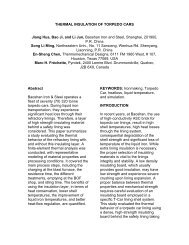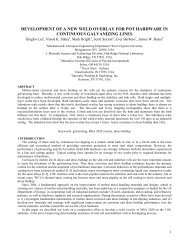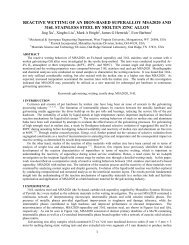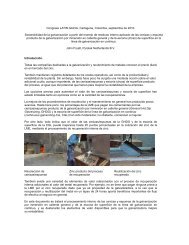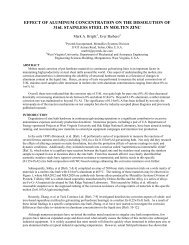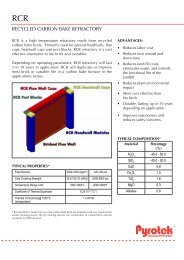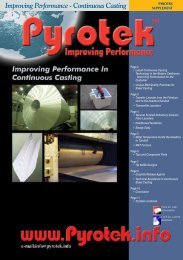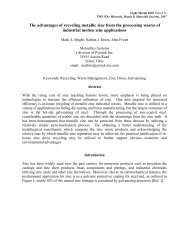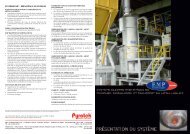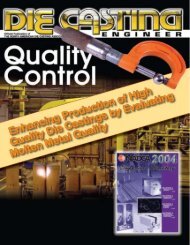improving performance in furnace melt treatment process - Pyrotek
improving performance in furnace melt treatment process - Pyrotek
improving performance in furnace melt treatment process - Pyrotek
You also want an ePaper? Increase the reach of your titles
YUMPU automatically turns print PDFs into web optimized ePapers that Google loves.
Alan Peel,<br />
Manag<strong>in</strong>g Director<br />
EMP Division<br />
Page 4<br />
In-Furnace Melt Treatment Process<br />
Purchas<strong>in</strong>g<br />
pure<br />
alloy elements<br />
<strong>in</strong> a form<br />
that can be<br />
charged<br />
directly<br />
<strong>in</strong>to the<br />
vortex of an<br />
EMP System<br />
also can give<br />
some<br />
f<strong>in</strong>ancial<br />
benefits.<br />
ALLOYING - A Critical First Step<br />
In Improv<strong>in</strong>g Melt Treatment<br />
Performance<br />
Alloy<strong>in</strong>g is the modification of <strong>melt</strong><br />
chemistry to meet cast<strong>in</strong>g specifications. It<br />
is typically done <strong>in</strong> the <strong>melt</strong><strong>in</strong>g <strong>furnace</strong> and<br />
adjusted <strong>in</strong> the hold<strong>in</strong>g <strong>furnace</strong>s or dur<strong>in</strong>g<br />
transfer. Alloy<strong>in</strong>g elements <strong>in</strong>clude, but are<br />
not limited to: silicon, iron, magnesium,<br />
manganese, copper and chromium. Stirr<strong>in</strong>g<br />
and <strong>melt</strong> homogenization are key<br />
components of the alloy<strong>in</strong>g <strong>process</strong>.<br />
Alloy<strong>in</strong>g cycle times must allow for<br />
adequate dissolution time as well as for the<br />
time required to complete proper <strong>furnace</strong><br />
skimm<strong>in</strong>g, ref<strong>in</strong><strong>in</strong>g and settl<strong>in</strong>g. For certa<strong>in</strong><br />
applications, there is a need to select highgrade<br />
alloys (for example, low Fe and Ca<br />
silicon metal for wheel/rim alloys).<br />
To maximize efficiency, operat<strong>in</strong>g practices<br />
must measure alloy<strong>in</strong>g recoveries, adjust<br />
<strong>furnace</strong> temperatures and <strong>process</strong><strong>in</strong>g<br />
techniques to optimise alloy additions. If<br />
operat<strong>in</strong>g <strong>in</strong> conjunction with a primary<br />
s<strong>melt</strong>er, it is often possible to utilise the hot<br />
metal superheat – a potential source of free<br />
<strong>furnace</strong> energy. Use powders, flakes and<br />
tablets rather than <strong>in</strong>got or waffle to reduce<br />
energy costs and to accelerate dissolution<br />
rates when they can be efficiently stirred<br />
<strong>in</strong>to the metal.<br />
The use of effective techniques to facilitate<br />
forced circulation of the <strong>melt</strong> dur<strong>in</strong>g the<br />
<strong>melt</strong><strong>in</strong>g and alloy<strong>in</strong>g phases of the <strong>process</strong><br />
demonstrates improvements <strong>in</strong> cycle times<br />
and more efficient use of expensive alloy<strong>in</strong>g<br />
materials.<br />
The EMP and Metaullics division both offer<br />
the LOTUSS vortex system which is a<br />
highly effective method of submergence for<br />
both scrap and alloy<strong>in</strong>g materials.<br />
Traditional methods for alloy<strong>in</strong>g <strong>in</strong> the cast<br />
house utilized pre-prepared master alloys.<br />
These are charged directly <strong>in</strong>to the <strong>melt</strong><strong>in</strong>g<br />
or hold<strong>in</strong>g <strong>furnace</strong> and ‘stirred <strong>in</strong>’ with the<br />
assistance of the dross rake. The problem<br />
associated with this technique is that it tends<br />
to take longer for the alloy addition to<br />
become fully mixed <strong>in</strong>to the <strong>melt</strong> as the<br />
mix<strong>in</strong>g is reliant upon the dross<strong>in</strong>g tool to<br />
PYROTEK<br />
SUPPLEMENT<br />
fully mix the bath and master alloys. In an<br />
attempt to overcome this problem of<br />
effective mix<strong>in</strong>g, the master alloys are<br />
usually made with a special flux that<br />
accelerates the mix<strong>in</strong>g of the alloy addition<br />
<strong>in</strong>to the <strong>melt</strong>.<br />
The EMP and Metaullics pump<strong>in</strong>g systems<br />
for light gauge scrap additions have the<br />
advantage of the unique vortex well as a<br />
medium for the addition of alloys <strong>in</strong>to the<br />
<strong>furnace</strong>. The <strong>furnace</strong> door is kept closed<br />
dur<strong>in</strong>g the entire <strong>process</strong>, with the follow<strong>in</strong>g<br />
three operat<strong>in</strong>g benefits:<br />
Ma<strong>in</strong>ta<strong>in</strong><strong>in</strong>g the heat transfer efficiency<br />
of the <strong>furnace</strong>,<br />
M<strong>in</strong>imis<strong>in</strong>g energy losses, and<br />
M<strong>in</strong>imis<strong>in</strong>g environmental emissions to<br />
the casthouse and operators.<br />
The LOTUSS vortex system elim<strong>in</strong>ates the<br />
need to alloy directly through the <strong>furnace</strong><br />
doors or by us<strong>in</strong>g specially made alloy<br />
tablets. The pure elemental additions Mn<br />
flake, Fe splatter, Cu cutt<strong>in</strong>gs/swarf and Mg<br />
bars can now be used <strong>in</strong> an effective way<br />
by charg<strong>in</strong>g directly through the EMP<br />
Vortex.<br />
Fig. 1 Magnesium Ingots Charged Directly Into<br />
the EMP Vortex<br />
Economic Benefits to Alloy<strong>in</strong>g Through<br />
The Vortex<br />
With the appropriate feed<strong>in</strong>g equipment,<br />
alloys from lump silicon to magnesium have<br />
been effectively charged <strong>in</strong>to a <strong>furnace</strong> with<br />
significant reductions <strong>in</strong> alloy losses and an<br />
improved dissolution time of the alloy <strong>in</strong>to<br />
the <strong>melt</strong>.<br />
The follow<strong>in</strong>g graph demonstrates the fast<br />
dissolution of magnesium <strong>in</strong>gots through a<br />
vortex.





